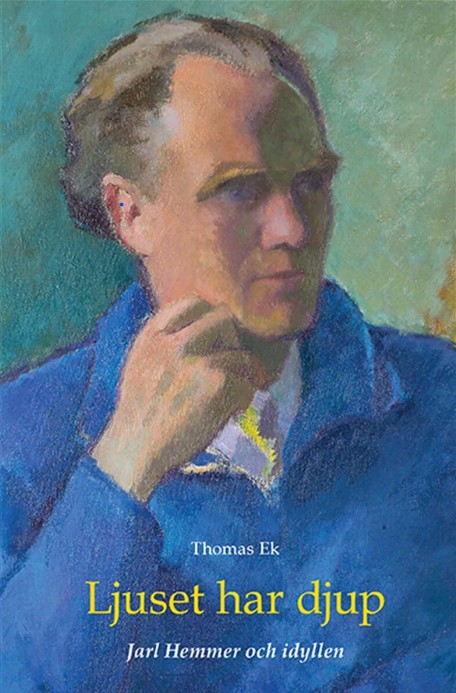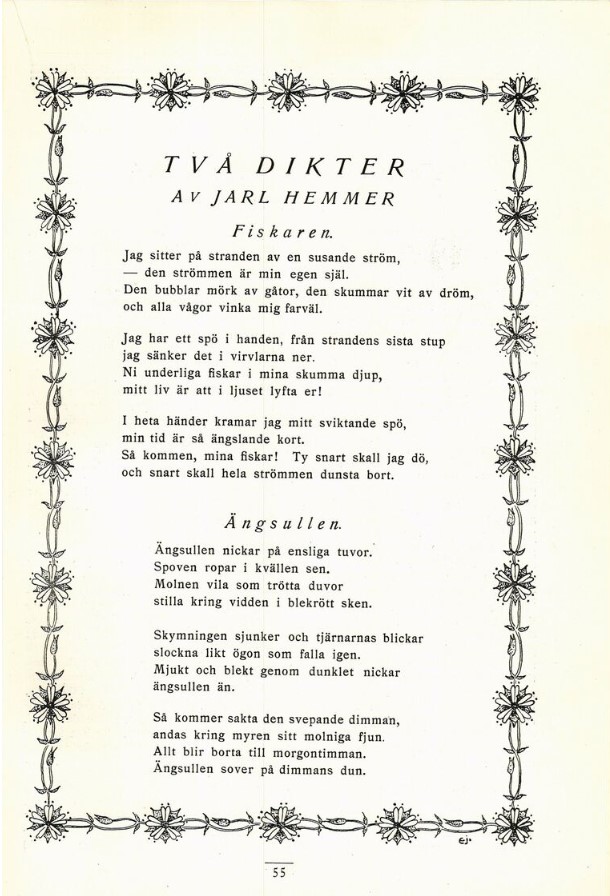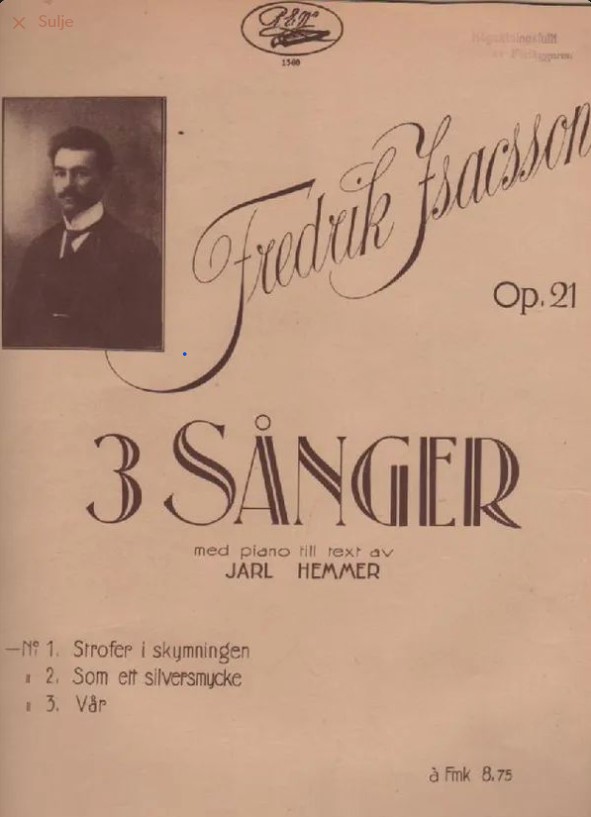Jarl Hemmer (1893 – 1944), poet and writer Topp
Jarl Hemmer was born in the town of Vaasa the 18th of September 1893 as a son to the Vice District Commissioner Balder Hemmer (1864-1947) and his wife Emmy, born Finnilä (1866-1943). There were two more brothers, Doctor of Law and Professor Ragnar Hemmer and lawyer and Vice District Commissioner Fjalar Hemmer. The grandparents were Eric Erland Hemmer (1823-1911) and Albertina Mathilda, born Zengerlein (1828 – 1902).
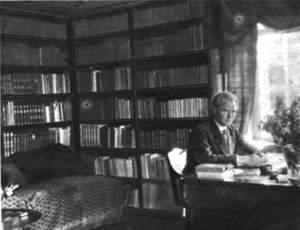


Hemmer House Topp
The family moved in 1895 to Koulukatu 8 in Vaasa, the house that is now Hemmer House. This building was designed by master builder A.Mannelin and built in 1886 for assistant judge Stenbäck. The house was donated to Stundars in 1977 by the Wasa Steam Mill inc. and in 1981 it could be reopened as a house for culture at Stundars open-air museum. Architect Marja Kyyhkynen planned the reconstruction.
Studies Topp
Jarl Hemmer lived in this house until 1912 when he finished secondary school and moved to Helsinki to become a student of the Russian language and literature at Helsinki University. Hemmer got his Bachelor of Philosophy in 1917. He married Saga Söderman (1897 – 1987) and the pair lived part-time in the Author´s house in Porvoo and part-time at a summer residence in Eckerö, Åland. They had two children, the son Erland born in 1918 and the daughter Marie-Louise born in 1920.
Authorship Topp
Jarl Hemmer both lived with and wrote about the dark as well as the light side of life. The most beautiful, light and joyous poems are from his youth. The debut was in 1914 with the collection of poems called “Rösterna” (the name of the translation is “The Voices”). When Hemmer wrote the ”Fattiggubbens brud” he spent some time in the village of Jungsund in Mustasaari municipality (1926). “Rågens rike” (the title of the translation from 1938 is “The Realm of the Rye”) from 1922 was inspired from Vindala. Hemmer is probably most known for the book ”En man och hans samvete” (1931) telling about the Finnish civil war in 1918 and its consequences and aftermath. He also got some international attention and received several awards, in Sweden among other countries. In Jarl Hemmer’s works, there is a note of an unhappy love story, but at the same time, it was probably the disappointment that triggered his literary production. Jarl Hemmer died in the Author’s House in Porvoo in 1944.
Bibliography Topp
- Rösterna. Dikter. Borgå 1914. (2 tillök. uppl. Helsinki 1918).
- Fantaster. Borgå 1915.
- Pelaren och andra dikter. Borgå 1916.
- Förvandlingar. Fyra berättelser. Helsinki 1918.
- Ett land i kamp. Tio dikter. Helsinki 1918.
- Prins Louis Ferdinand av Preussen. En romantisk cykel. Helsinki 1919.
- Jordens sång. Kantat vid Åbo akademis invigning lördagen den 11 och söndagen den 12 oktober 1919. Musiken av Jean Sibelius. 4:0, 10 s. Åbo 1919. Åbo Akademi.
- Över dunklet. Dikter. Helsinki 1919.
- Onni Kokko. Berättelse. Helsinki 1920.
- De skymda ljusen. Helsinki 1921.
- Vi ha ett större fosterland. Festdikt vid svenska Österbottens kulturvecka midsommaren 1921. (3) s. Vasa 1921.
- Rågens rike (Episk dikt.) Stockholm 1922.
- Väntan. Dikter. Helsinki 1922.
- Med ödet ombord. En dramatisk dikt. Helsinki 1924.
- Anna Ringars. Skådespel. 1925.
- Skärseld. Dikter och dokument. Helsinki 1924.
- Fattiggubbens brud. En passionshistoria. Helsinki 1926.
- Budskap. Sex noveller. Helsinki 1928.
- Du ljusa land. Festdikt, tillägnad Ålands Sång- och musikförbund den 8 juli 1928. Mariehamn 1928.
- Helg. Dikter. Helsinki 1929.
- En man och hans samvete. Stockholm. 1931.
- Morgongåvan. Stockholm 1934.
- Nordan. (Dikter.) Stockholm 1936.
- Klockan i havet. (Dikter.) Helsinki 1939.
- Du land. Femton tidsdikter. Helsinki 1940.
- Varia: Brev till vänner. Anteckningar, essäer, minnesord. Helsinki 1937.
- Tolkn.: Lyriska översättningar. Helsinki 1922.
- Saml. uppl. och urval: Lyrik i urval. 1914-1929. Helsinki 1937.
- Skrifter. Minnesupplaga. 1-4. Helsinki 1945-46.
- Dikter i urval. Helsinki 1959 (Finlandssvenskt bibliotek.7.)
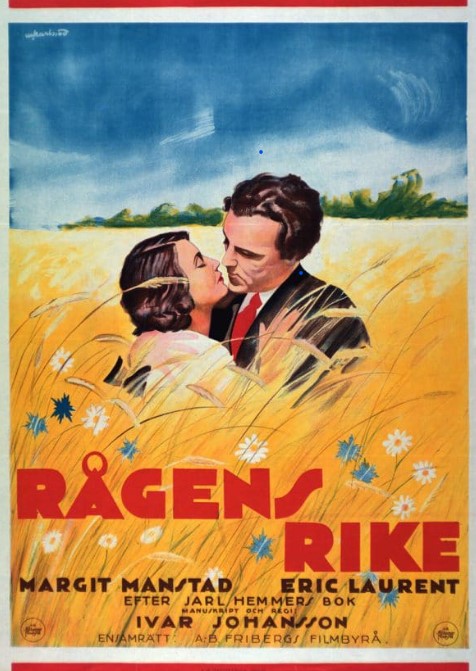
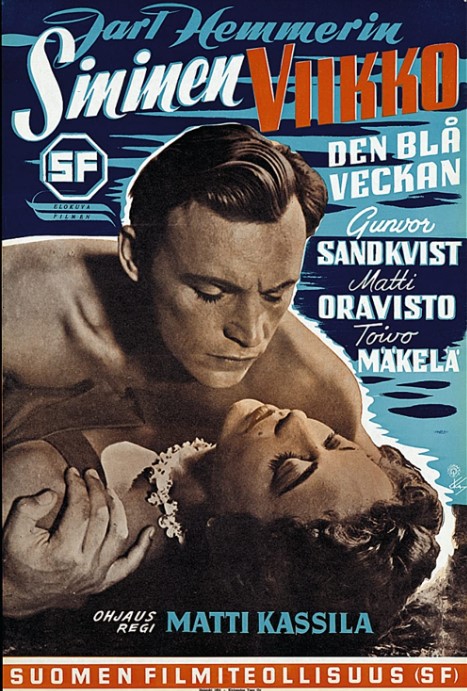

Archive materials Topp
The Stundars Association has in its possession the archive of Jarl Hemmer, mostly books. It contains his own dedicated copies of his books to the wife, Saga, and different translations of his works. Parts of the library of his parents, among others his grandfather’s scientific literature about forestry and land surveying, are also included. These books come from the lawyer Fjalar Hemmer’s home and have been donated to Stundars Local History Society. Fjalar, a brother of the poet, had inherited them from the forester Erland Hemmer.
Literature belonging to the mother Emmy, born Finnilä, is also part of the library archive at Hemmer House. This library naturally contains some literature from the early 19th century, but most books are from the end of the 19th century. Some books are the ones that Jarl and Saga kept in their home, and that Saga had in her possession as a widow. The books are kept in a locked bookcase in Hemmer House.
There are also documents and other materials from Jarl Hemmers life in Stundars’ archives, for example personal letters, handwritten manuscripts, documents concerning the death of Jarl Hemmer and photographs.
